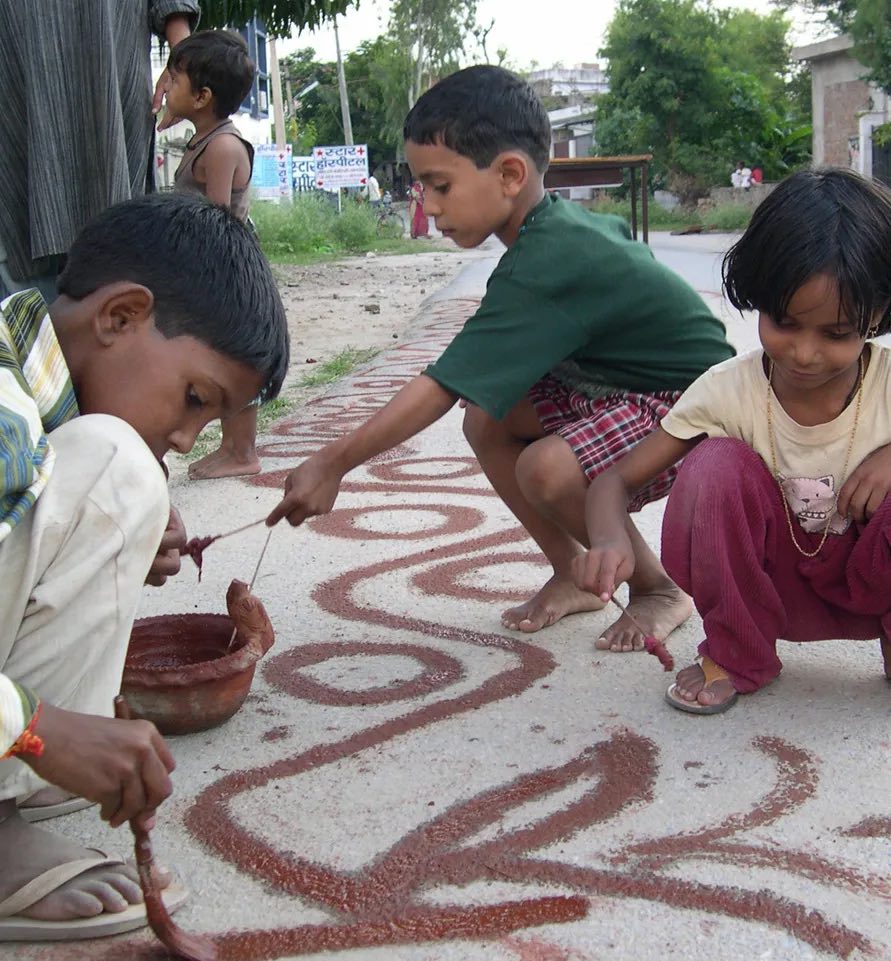Leadership Is Friendship
I just received one of the sweetest compliments I have ever been given.
Nandita, at our Asian Diaspora Jam team retreat last week, said to me, “Your leadership is friendship.”
I was deeply moved to hear this, not just because it spoke to one of the values I hold most dear, but also because there was no ‘like’ in it, as in, “Your leadership is like friendship.” It was simply a declaration — a statement of fact rather than a simile — and tapped into something profound for me and, perhaps, crucial for these times.
I have been thinking a lot about leadership for the last 35 years of my life. My Capricorn Fire Dragon self has no choice in the matter. And yet, I never put it this way before. I have thought about shared leadership; distributed power; the ripple effect of a leadership team (as in, ‘So goes the team, so goes the Jam’); seeing each person as a leader; how a leader is ‘anyone who wants to contribute at this time’; all of us co-leading and weaving towards a common goal; co-creating a way of being as leaders; and a myriad of other forms/concepts/frameworks of reciprocal, interconnected, interdependent leadership.
At the same time, I have also believed that “friendship is a core engine of social change.” From my early passions for environmental and human rights work as a tween and teenager, to my youth-focused creative work in college, to my community-driven work with Shikshantar in India, to my time as Executive Director at YES!, to this current transitional period in my life — over and over again, I have seen that relationships are at the root of Everything. Befriending people, and having them be friends with me, has launched hundreds of projects and organizations; generated tons of books, videos, podcasts, and articles; moved millions of dollars towards healing and transformation, and simply made it possible for people who care about things in the world to also feel cared for, uplifted and sustained, so that they can do and be the change they want to see in the world. I have seen friendship make leadership come alive in all ways, shapes, levels and contexts.
So, could it work in reverse? Could leadership be seen as friendship? Is it as simple as caring for another and then collaborating with what grows from there?
When I think about friendship, three core stages come to mind. First, when I am making a new friend, I feel curious about them — their stories, their passions, their struggles, their wisdoms. I ask questions and listen to them, and they do the same for me. Together, we laugh and find resonance. We also discover our differences and enjoy diving into them, to keep learning more about each other. In this process, if the friendship is building, I begin to feel comfortable with them, and they feel that with me. It’s warm and sweet, and/or soft and tender, and/or funny and sassy, and/or all of the above. There’s a texture of ease that emerges through our mutual curiosity and willingness to share and listen.
Then, as the friendship grows and deepens, Stage 2 emerges. I celebrate and care for that friend, and they do that for me. The more I learn about them, the more I appreciate them in every way I can. I lift up their talents and gifts and want to help them with their work, projects, life journeys. I connect them to good folks I know, work through a problem with them, and give support as needed and as I am able. I commit to showing up for that friend, to be there when things are going well, and also when they are not. I have their back, and they have mine. And, we create things together — everything from dinner parties, to magazines, to healing gatherings, to new movements and organizations. We show up for each other, and we do good/fun/meaningful things together.
I have so many examples of friendships like this. In my childhood, and through high-school and college, it happened more naturally and unconsciously with sports, clubs, dorm life, etc. Then, when I was in India and working with Shikshantar’s Udaipur as Learning City, it started to become more conscious and visible.
I’ll give a shout-out to my brother, Manish, and sister-in-law, Vidhi, for articulating how curiosity, care and co-creation develops friendships for social change. They called it the ABCD approach: Appreciating the gifts and potential of each person; Building caring relationships and connections; Challenging dehumanizing and oppressive systems; and Developing shared visions and practices of swaraj (a combination of radiance of the self and community sovereignty). This understanding and process, influenced by the lens of appreciative inquiry, has permeated the work of Shikshantar since its inception.
I remember how in 1999, when they were just starting out, Manish and Vidhi met a young local artist, Shahid Parvez, at his small gallery while wandering around the old city of Udaipur. They started talking about his art and how it was to be a young artist, and Shahid shared how he felt frustrated that children weren’t being given a creative space in schools. Through their open-hearted conversation, a friendship began to emerge. A short time later, Shahid decided he wanted to volunteer two hours a day for a month to make a creative learning space for young people from under-served communities. I was part of this first offering, and it was incredible. Grounded in kindness, love, generosity, and curiosity, the kids’ art unfolded — as did so much fun and connection. Ultimately, it led to a city-wide exhibition that inspired many families, local artists, and Udaipur’s general public about the power of creativity and what we could generate when we paid attention to the conditions and the relationships around us.

Friendships like the one with Shahid started to become the norm in our work with Shikshantar, and over and over, inspiring leadership emerged as a result. Beautiful community projects around zero waste, puppetry, rainwater harvesting, herbal medicine, healthy food, street theater, and more, came into existence, as we slowed down and listened and related with people of all ages and backgrounds. Friendship led to leadership, and leadership was initiating and sustaining those friendships. I feel so lucky to have been steeped in this culture when I lived in Udaipur for nearly 10 years, and those practices have fundamentally guided me in the 15 years since.
Along the way, I have come to recognize another stage of friendship: weathering the storms. In the beginning and middle stages, I experience a kind of flow in the relationship, an equitable balance in the giving and receiving. There is beauty, and the friendship can hang out here for quite some time. However, in the third stage, I have to face a break in the flow. Either I said or did some things they didn’t like, and/or vice versa, or we had to work out something challenging, maybe involving hurt feelings or important pieces of feedback. The storm has come, and we need to see if we can weather it.
Stage three is where I know lifelong friendships live. Meeting those conflict moments as friends means we are talking it through, listening, learning, forgiving each other, adapting, and moving forward together. In this process, we co-create an energy — something that goes beyond us individually. It’s almost like the relationship becomes its own entity. And, once generated, I have found that there really isn’t anything that can eliminate the bond. We have worked through conflict together, and the friendship can stand on its own feet. I feel grateful to have many beloved friends that I share this with, where we have found our way through challenges and keep growing the world we want to see together. And, I also hold a tender place in my heart for those friendships that couldn’t make a way through the storm and came to an end.
I sense this is what it means when Leadership Is Friendship: practicing these three stages combined, cyclically and consistently. It is being curious, committed to learning, sensing the gifts in a person and lifting them up to their highest purpose, and weathering the storms to understand, to forgive, and to keep building and growing together. Not surprisingly, it mirrors the levels of community I shared about in an earlier writing.
To take it a notch inward, I can befriend myself as I befriend others. I don’t need to be my own worst enemy, succumbing to the inner critic in my mind, which stymies my leadership and my relationships. Rather, I can do as Abe Lincoln said, and remember that “the best way to get rid of an enemy is to make them a friend.” Just as I practice these stages with others, I can apply them internally to myself. In the process, I become more of the leader — and more of the human — I want to be. Bringing curiosity, mutuality, and generative conflict to my inner sphere, reveals more dimensions of my leadership to me, while also easing my work and life tremendously.
I wish I saw more of this kind of leadership in our political sector, which seems so bent on creating enemies of others — maybe because they are enemies of themselves. Yet, how deep and vast could things shift in our world if people were befriending each other, and themselves, and leading from there?

Friends facing the world together. Photo by Geraldine Teotico.
Perhaps Leadership Is Friendship is part of the commitment to slow change (as described in a recent article by Rebecca Solnit). It counters the urgency and scarcity so prevalent in social/environmental/political change work, which often creates leaders who are dominating and discarding people. Instead, it invites us to become more intentional, to tune in and embrace the everyday care that leads to powerful action, in ourselves and with others. While the big breakthroughs or extra-special memories can exist, of course, Leadership Is Friendship is more about the many small moments of simply checking in, being there for each other, and giving a loving boost. My friend finds their way, and I find mine, and we do it, hand in hand, together.
Leadership Is Friendship posted on Substack.
Subscribe to Shilpa’s Substack.


